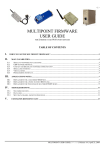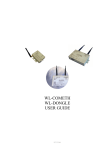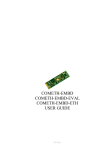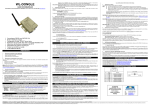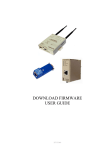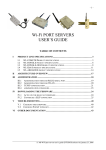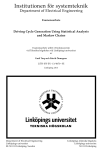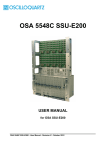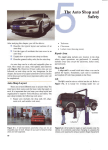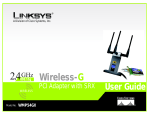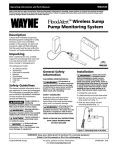Download TCP-CLIENT FIRMWARE USER'S GUIDE
Transcript
-1- TCP-CLIENT FIRMWARE USER’S GUIDE FOR ETHERNET AND WI-FI PORT SERVERS TABLE OF CONTENTS I. INTRODUCTION ....................................................................................................................................... 5 II. WHEN TO USE THE TCP CLIENT FIRMWARE ?......................................................................... 7 III. USING THE TCP CLIENT FIRMWARE ........................................................................................... 9 III.1 III.2 III.3 III.4 IV. THEORY OF OPERATION ........................................................................................................................ 9 CONFIGURATION ................................................................................................................................. 10 LED INDICATOR .................................................................................................................................. 10 USING THE SOCKET INTERFACE ....................................................................................................... 10 COMMANDS REFERENCE LIST .................................................................................................... 11 TCP CLIENT USER GUIDE (D D T U DT TU USSS000444555) Release A.5, June 2, 2010 -2- TCP CLIENT USER GUIDE (D D T U DT TU USSS000444555) Release A.5, June 2, 2010 -3- TCP CLIENT FIRMWARE USER GUIDE COPYRIGHT (©) ACKSYS 2010 This document contains information protected by Copyright. The present document may not be wholly or partially reproduced, transcribed, stored in any computer or other system whatsoever, or translated into any language or computer language whatsoever without prior written consent from ZA Val Joyeux – 10, rue des Entrepreneurs 78450 VILLEPREUX - FRANCE. REGISTERED TRADEMARKS ® • ACKSYS is a registered trademark of ACKSYS. • Windows is a registered trademark of MICROSOFT. NOTICE ACKSYS ® gives no guarantee as to the content of the present document and takes no responsibility for the profitability or the suitability of the equipment for the requirements of the user. ACKSYS ® will in no case be held responsible for any errors that may be contained in this document, nor for any damage, no matter how substantial, occasioned by the provision, operation or use of the equipment. ACKSYS ® reserves the right to revise this document periodically or change its contents without notice. ZA Val Joyeux 10, rue des Entrepreneurs 78450 VILLEPREUX FRANCE Telephone: Fax: Web: Hotline: Sales: +33 (0)1 30 56 46 46 +33 (0)1 30 56 12 95 www.acksys.fr [email protected] [email protected] TCP CLIENT USER GUIDE (D D T U DT TU USSS000444555) Release A.5, June 2, 2010 -4- PPA AG GE E IIN NT TE EN NT TIIO ON NA AL LL LY YL LE EFFT TB BL LA AN NK K TCP CLIENT USER GUIDE (D D T U DT TU USSS000444555) Release A.5, June 2, 2010 -5- I. INTRODUCTION The TCP CLIENT firmware may be used with any product of the ACKSYS port servers range. It allows any computer or device equipped with an asynchronous serial interface, to connect to a remote computer or device over a TCP/IP network. On its own or on behalf of the serial device, the port server can initiate a raw TCP connection with a selected network server. Then an application program on the network server can exchange data to and from the port server serial port (thus with the device connected to this port). Serial port control signals, though not transmitted over the network, can be used locally on the port server to drive certain functions: automatic connections, flow control. The TCP CLIENT firmware functions as a network client. This means that it provides no service to the network: instead, it volunteers to connect to a network server as soon as proper local conditions allow (serial device ready for example). Administration. Even while TCP CLIENT is connected to a network server, TELNET can be used to access the port server administration interface. Example 1: connection to an application program. Port server serial Serial equipment Ethernet Client TCP/IP network (Intranet / Intranet) Server application with SOCKETS API When the serial equipment is powered on, the port server calls the server application which can then exchange data with the equipment. When the serial equipment is powered off, the port server closes the connection to the application. The application only knows about connected equipments, thus allowing dynamic adds and removes. TCP CLIENT USER GUIDE (D D T U DT TU USSS000444555) Release A.5, June 2, 2010 -6Example 2: tunnelling serial data through a network. The TCP CLIENT firmware (which is a network client) can call another port server equipped with the SERVERCOM firmware (which is a network server). This establishes a transparent data link over the network. Serial device #1 Serial device #2 serial serial Ethernet TCP/IP network Ethernet (Intranet / Intranet) Port server+TCPCLIENT Port server+SERVERCOM Client Server The serial equipments are connected in a transparent way through the network Example 3: Redundant application servers. In these cases where the serial device must be serviced even in case of server failure, supplementary servers can be predefined so that the TCP CLIENT firmware will try to connect to each server successively, until one server responds in a timely fashion. Port server TCP serial Serial device Ethernet TCP/IP network (intranet / Internet) Network server Network server Computers holding a Server with SOCKETS Servers #1 and Port server SERVERCOM TCP CLIENT USER GUIDE (D D T U DT TU USSS000444555) Release A.5, June 2, 2010 -7- II. WHEN TO USE THE TCP CLIENT FIRMWARE ? In order to identify the cases where TCP CLIENT can be used, it is important to know that the TCP CLIENT firmware has the following properties: • It uses TCP communications on the network side, forbidding undetected data loss at the expense of slower communications. • It conveys no protocol information in the data exchanged between the remote application software and the device connected to the port server. • It can handle serial communications up to 230400 bauds. • It can drive and monitor serial control signals, locally only (not from/to the remote). The TCP CLIENT firmware can be used to solve the following needs: • Application software using a TCP SOCKET to exchange data with a remote serial device, when the number of such devices is changes in the time. • Application software using a TCP SOCKET to exchange data with a remote serial device, when the application has scarce resources to allocate (only active TCP CLIENTS require TCP resources in the server). • Two-ways tunnelling raw data between a SERVERCOM port server and a TCP-CLIENT port server. • Tunnelling MODBUS frames (or other asynchronous protocols) in pointto-point configurations. • Connection of a remote serial console to a multiuser computer system. TCP CLIENT USER GUIDE (D U T D USSS000444555) Release A.5, June 2, 2010 TU DT -8- PPA AG GE E IIN NT TE EN NT TIIO ON NA AL LL LY YL LE EFFT TB BL LA AN NK K TCP CLIENT USER GUIDE (D U T D USSS000444555) Release A.5, June 2, 2010 TU DT -9- III. USING THE TCP CLIENT FIRMWARE III.1 Theory of operation The network configuration, including IP address, netmask, gateway (router) address, DHCP, and so on, is described in the port server user manual. To establish a TCP connection, the port server must be given the server IP address. The firmware lets you set up an array of up to eight servers (see command “set net server”) with indices ranging from 0 to 7. Servers at lower indices in this arraye take precedence over servers at higher indices. Upon reset, the first connection is launched on the valid server IP address whose index is the lowest in the array. Server IP addresses set to 0.0.0.0 are considered unused. Three events can trigger connection requests to the TCP server: • “set serial opencon permanent”: Permanent connection. As soon as the port server is powered on, it tries to connect to a server. • “set serial opencon dsr”: connection driven by the DSR signal. A connection call takes place when the DSR control signal is in high state.When the DSR control signal drops, the port server closes the connection with the server. Then, when the DSR rises again, the connection request is targetted to the same server. No more than four reconnections per minute can take place due to a DSR drop. The special case “set serial opencon dsri” will forcefully resets the TCP connection instead of closing smoothly when the DSR drops, thus making the DTR drop immediately if configured to “modem” mode. • “set serial opencon data”: connection once-per-dataframe: This mode is available on the Ethernet ports servers only. A connection call takes place when data is received on the serial port. When the configured send condition is met (command “set sendtrigger”), the accumulated serial frame is sent to the server and the connection is immediately closed. No data can be received from the TCP server in this mode. If the call times out, the data frame is lost. If another data frame arrives before the call is acknowledged, only the last frame received is sent, previous frame(s) will be lost. The call will not time out while it is delayed due to low resources in the port server. No more than four reconnections per minute can take place. In all cases, if connection with the server is closed or lost, a new connection request is immediately launched on the next server. When the array of servers is exhausted it is looked up from the beginning once again. In order to avoid loading the network with connection requests, a time out can be set with the following commands: • “set net TimeEstCon” which limits the waiting time when a server does not answer immediately; • “set net TimePollServ” which restrains permanent polling of the defined servers, should they all reject the connection request. This defines a polling interval for the group of servers. TCP CLIENT USER GUIDE (D U T D USSS000444555) Release A.5, June 2, 2010 TU DT - 10 - III.2 Configuration The factory default firmware is not TCP CLIENT. You must first activate the required firmware. Please refer to the port server user manual for information about how to do this. The port server comes with defaults settings for the TCP CLIENT firmware. These settings can be reinstated with the “set default” command. Important settings are: • sendtrigger: by default the port server sends incoming serial data onto the network when some idle time elapse after the last character received. You can set alternate conditions. See the detailed documentation of this command. • flow control: by default the port server uses no local flow control. Often you will want to change this. See the detailed documentation of the “set serial” commands. Let’s say that you connect the port server to a device that sends a continuous data flow at 1200 bauds. The default sendtrigger works, but since there is never an idle time in the serial flow, data is sent to the remote server only when a full packet is built, which is every 4.2 seconds using large 512 bytes chunks. While this keeps the network bandwidth use low, you might want the server to receive faster in smaller chunks. A better sendtrigger in this case is: set sendtrigger charcount 10c which sends evey 10 bytes, i.e. every 80ms at 1200 bauds. Do not forget also in this case: set serial baudrate 1200 Let’s say that you connect the port server to a device which honors the XON/XOFF protocol. Then you can set it in the port server: set serial xonxoff use Let’s say that you connect the port server to a device which honors the RTS/CTS protocol. Then you can set it in the port server: set serial rts flow set serial cts flow III.3 Led indicator The diagnostic LED (red LED) blinks five times per second to indicate that connection with a server TCP is not established. III.4 Using the SOCKET interface Application software can use the SOCKET interface to communicate with a port server running the TCP CLIENT firmware. This involves setting up a TCP socket, and using it to listen for incoming connections. Usually serverside application sofware should activate keepalives. TCP CLIENT USER GUIDE (D U T D USSS000444555) Release A.5, June 2, 2010 TU DT - 11 - COMMANDS REFERENCE LIST IV. Displaying the configuration parameters is allowed if the showperm parameter is set to « allow ». If it is set to « deny », the configuration parameters can only be displayed by the administrator after logging in. Some parameters can only be displayed for your information but cannot be changed. Conventions used in these tables: • bold text must be typed as is. • italicized text denotes a parameter which must be replaced by the proper value. • italicized bold text denotes warnings or limitations. Tables: • • • • • • general parameters network parameters wireless parameters serial parameters parameters available only for the "WLg" products range notes TCP CLIENT USER GUIDE (D U T D USSS000444555) Release A.5, June 2, 2010 TU DT - 12 SETTING OR DISPLAYING THE GENERAL PARAMETERS Command Default value Notes Description login username start the administrator identification sequence. Ask password. set default restore factory defaults, except the MAC address, the save count, the current firmware and the next firmware to run. save save the current configuration to the permanent configuration memory which is used after reboot and remains when the device is powered off. reset close the administration session and reboot the device, to ignore parameters changed but not saved, or to reload saved parameters. The following parameters do not need a reset to take effect: location, showperm, netconfigperm, serial interface. show quit set show set show set show set show login login password password location location showperm showperm username root display firmware name and version close administration session (TELNET only). change/display administrator username. 8 bytes max. Upper and lower cases. password root change/display administrator password. 8 bytes max. Upper and lower cases. location “Unknown location” perm allow set show set show netconfigperm netconfigperm upgradeperm upgradeperm perm allow perm allow change/display location description of the device server. 30 bytes max. Upper and lower cases. change/display the right to display configuration information without entering the administrator password. perm : one of allow / deny change/display the right to use the administration system from the network. perm : one of allow / deny change/display the right to upgrade the firmware. perm : one of allow / deny If this flag is set to “allow”, upgrade is allowed. (through serial port or Wifi interface) else upgrade is not allowed. These commands are not available for devices providing several firmwares simultaneously. version TCP CLIENT USER GUIDE (D U T D USSS000444555) Release A.5, June 2, 2010 TU DT - 13 The following commands are available only in devices that provide several firmwares simultaneously. set show prog enable prog enable show show show prog list prog info prog data seg seg seg TCPCLIENT firmware located in seg /5 execute after next reset the current firmware located in segment seg. Display this firmware. display information about all firmwares. display information about firmware located in segment seg, in computer readable format. display information about firmware located in segment seg, in computer readable format. TCP CLIENT USER GUIDE (D U T D USSS000444555) Release A.5, June 2, 2010 TU DT - 14 SETTING OR DISPLAYING THE NETWORK PARAMETERS Command Default value show set show set net ethernet net dhcp net dhcp net dhcp clientid Factory defined off set show set show net dhcp clientid net dhcp clientid net dhcp hname net dhcp hname set show set show set show set show set net ip net ip net mask net mask net gateway net gateway net metric net metric net keepalive show set set net keepalive net keepalive net segtmo show show net segtmo net config port state ident empty (MAC address sent as string) Notes Description display Ethernet address. 6 hex digits separated by columns. turn on /off or display the DHCP client use. When dhcp is on, the manually specified IP address is not used. replace the standard client ID enforced on DHCP option 61 (MAC address as a string) by the custom string ident. 15 bytes max, upper and lower cases allowed. hostname empty (not sent) aaa.bbb.ccc.ddd 192.168.1.253 delete the custom client ID and use the default client ID. display custom client ID provide the DHCP server with the supplementary Host Name option, with value hostname. 19 bytes max, no spaces allowed, upper and lower cases allowed. Value assigned to DHCP option 12, if any. change/display IP address in dotted decimal notation. aaa.bbb.ccc.ddd 255.255.255.0 change/display local subnet mask aaa.bbb.ccc.ddd 0.0.0.0 change/display the gateway IP address. mmm 64 (“WLg”) 10 (others) 3/3/1 (“WLg”) Off (others) change/display the number of gateway hops. mmm is 1 to 255 n t1 t2 000 delay 4 (“WLg”) Off (0) (others) 23 n defines the number of probes to send before closing the connection. t1 defines the time in seconds before sending the first probe since the connection is inactive (the “activation delay” mentioned earlier). t2 defines the time in seconds between each probes (the “interval delay mentioned earlier). n ranges from 1 to 255. t1 and t2 range from 1 to 65535. This command also resets the “segtmo” parameter to (t1 + t2 x n). display keepalive parameters as “n probes, t1/t2 sec”; else “keepalive off”. disables use of the keep-alive feature. delay defines the number of seconds the firmware will wait for acknowledgement of send data, after which it will consider that the network has failed and will abort the TCP connection. delay ranges from 0 (off) to 65535. Setting “keepalive” changes “segtmo”. display segtmo parameter value. administration port TCP CLIENT USER GUIDE (D U T D USSS000444555) Release A.5, June 2, 2010 TU DT - 15 Command set net server Default value Notes Description arrayIndex: index of the server in the servers array, 0 to 7. The servers table is processed in increasing index numbers. IPaddress : IP address of TCP server in dotted decimal notation. Port : TCP data port of TCP server. Port is 1 to 65535. ArrayIndex IPaddress Port Example : Set the TCP server at IP address 192.168.1.1, which runs an application listening to TCP port 3000, so that it is the first server called after a device power on: root> set net server 0 192.168.1.1 3000 set set show net server net timeestcon net timeestcon ArayIndex 0.0.0.0 duration 300 tenths of sec. set show net timepollserv net timepollserv duration 300 tenths of sec. note 9 Delete the TCP server in ArrayIndex duration is the time allowed to establish a connection with a server. At end of duration, if connection is not established, a connection request is issued to the next server. duration is 1 to 65535 in tenths of second. duration is 0 to disable the timer. This timer avoids to poll permanently all servers in the array, if they all refuse the connection. This timer is launched at the connection attempt on the first server in the array. When the array is exhausted, it will not be looked up again until duration has expired. Duration is 1 to 65535 in tenths of second. Duration is 0 to disable the timer. TCP CLIENT USER GUIDE (D U T D USSS000444555) Release A.5, June 2, 2010 TU DT - 16 SETTING OR DISPLAYING THE NETWORK WIRELESS PARAMETERS All commands of the “network wireless parameters” section are only valid for wireless device servers. Command set show set show net ssid net ssid net mode net mode set show set net channel net channel net wepkey set show set show net wepkey net wepkey net usekey net usekey set net auth Default value ssid acksys mode Ad-hoc (“WLg”) Infra (others) channel 6 keynum key no default value keynum 0 [keynum] [128] mode open Notes Description change/display the SSID of the device. SSID is a case sensitive characters string. (32 characters max). Empty character string is not allowed. configure/display the WIFI mode. One of ad-hoc or infra. ad-hoc : configure the device in AD-HOC mode . Infra : configure the device in infrastructure mode. In ad-hoc mode, configures the radio channel used for communication with the other device. channel is in the range 0 to 13. In infrastructure mode this parameter is ignored. define up to 4 WEP keys. keynum is the key number. Range 1 to 4. key is the hexadecimal key value. 10 digits (64 bits key) or 26 digits (128 bits key). The last 6 digits are generated by the firmware Example : set 64 bits WEP key : set net wepkey 1 1F2564AE12 set 128 bits WEP key : set net wepkey 1 123654875ADFEC236542541A26 Note : to enter a 128 bits WEP key, you must before enable 128 bits key mode. See command ”set net usekey 1 128” below. delete wepkey keynum display all 4 WEP keys (the last 6 digits are displayed as zeroes). define the WEP key to use. If the keynum parameter is left empty, device won’t use any WEP key, else device uses WEP key keynum. Example: Activate 64 bits WEP key set net usekey 1 Activate 128 bits WEP key set net usekey 1 128 Disable WEP key using set net usekey set the authentication mode. mode is one of open, share open : the device is authenticated by its MAC address. share : the device is authenticated by its WEP Key. This command is not valid for WL-COMETH I. TCP CLIENT USER GUIDE (D U T D USSS000444555) Release A.5, June 2, 2010 TU DT - 17 Command Default value set net unencrypted mode Ignore (WLg-range) Accept (other products) set net txrate txrate automatic show net wlan Notes Description configure if the device accept or ignore the unencrypted WIFI packet. mode is one of ignore or accept ignore : The device ignores all WIFI packet unencrypted accept : The device accepts all WIFI packet unencrypted This command is not valid for WL-COMETH I. set the WIFI transmit rate. txrate is one of 1, 2, 5.5, 11, automatic. 1, 2, 5.5 or 11: device will always use the given transmit rate. automatic: device will automatically choose the appropriate transmit rate. Display WIFI parameters : channel, txrate, authentification mode, RF signal quality. authentification mode is not displaying for WL COMETH I. “WLg” products also display avaible access points around. TCP CLIENT USER GUIDE (D U T D USSS000444555) Release A.5, June 2, 2010 TU DT - 18 SETTING OR DISPLAYING THE SERIAL PARAMETERS Command Default value set show serial interface serial interface mode [option] rs232 set show serial opencon serial opencon mode permanent set show serial dtr serial dtr mode high set show serial rts serial rts mode high set show serial cts serial cts mode ignore set show serial dcd serial dcd mode ignore set show set show serial ring serial ring serial baudrate serial baudrate mode ignore speed 9600 Notes Description mode : one of rs232/rs422/4wires/rs485/2wires option : master or slave for rs422 / 4wires mode, noecho or echo for rs485 / 2wires mode • On some products, only “rs232” is meaningful. Other choices will result in communication errors. See the serial port specifications of the appropriate port server user manual. • Keywords “rs422” and “4wires” are synonyms. Their meaning is identical. • Keywords “rs485” and “2wires” are synonyms. Their meaning is identical. rs232 : setting for rs232 serial interface equipment rs422 master or 4wires master : setting for master equipment in multidrop, configuration or for both equipments in point to point configuration rs422 slave or 4wires slave : setting for slave in multidrop configuration. rs485 noecho or 2wires noecho : setting for all devices in multidrop or point to point. rs485 echo or 2wires echo : setting for all equipments in multidrop or point to point configuration. In this mode, transmitted characters on RS485 line are echoed on Lan line. TCP connection request event mode : one of permanent / dsr / dsri / data permanent : connection requests take place as soon as there is no active connection (see also timeouts effect) dsr : connection/disconnection requests take place whenever DSR rises/falls. dsri : same as “dsr” but the DSR fall forcefully resets the connection with immediate effect. data : (available on Ethernet ports servers with TCP-Client v2.6 only) connection is established only for the time necessary to send a data frame, delimited by the send trigger. DTR management. mode is one of modem/high/low. Modem means the signal is used as if a modem was connected to the port (DTR the device is on line, RTS the device wants to send data). High and low mean the signal is permanently set in this state. RTS management. mode is one of high/low/flow. Flow means the signal is used for input flow control. High and low mean the signal is permanently set in this state. CTS management. mode is one of ignore / flow Flow means the signal is used for output flow control. Ignore means that the signal is locally ignored. DCD management. mode is one of ignore mode : always ignore. RING management : mode : always ignore speed : any baud rate from 10 bauds to 230400 bauds (up to 1’000’000 on RS422/RS485 “WLg” products) TCP CLIENT USER GUIDE (D U T D USSS000444555) Release A.5, June 2, 2010 TU DT - 19 Command Default value Notes Description nbits parity nstops 8n1 nbits is 7 or 8 bits, parity is one of e, o, n, m, s (meaning even, odd, none, mark or space), nstops is 1 or 2 stop bits. (nbits=6 bits is also supported on the “WLg” range) mode ignore count Off (0) notes 5,6 software flow control : mode is one of use or ignore. Mixed (i.e. software and hardware) flow control can be set. number of chars required in the buffer before emission to the client application. Allowed values range from 0 to 255. When this parameter is not 0, data received on the asynchronous serial port will not be sent to the client application until there are at least count characters in the buffer. Set this parameter to 0 to disable it. set sendtrigger framedelay delay Off (0) notes 5, 6, 7 delay between char reception and emission to the client application. Allowed values range from 0 to 255.The delay can be specified in milliseconds by appending a ‘m’ to the figure, or in character duration by appending a ‘c’ to the figure. ‘m’ is the default if no unit is specified. When this parameter is not 0, data received on the asynchronous serial port will not be resent to the client application until the specified delay has elapsed, after which, all data received in the meantime will be sent. Set this parameter to 0 to disable it. set sendtrigger idledelay 3 ms (“WLg” products) 2 char times (others) notes 5, 6, 7 delay between last char reception and emission to the client application. Allowed values range from 0 to 255.The delay can be specified in milliseconds by appending a ‘m’ to the figure, or in character duration by appending a ‘c’ to the figure. ‘m’ is the default if no unit is specified. When this parameter is not 0, data received on the asynchronous serial port will not be resent to the client application until the specified delay has elapsed since the last character was received, after which, all data received will be sent. Set this parameter to 0 to disable it. show sendtrigger send when timeout after 1st char = 2ms or buffer full notes 5, 6, 7, display the condition used to put the data received on the asynchronous serial port, in the queue for transmission to the client application. set serial format show set show set serial format serial xonxoff serial xonxoff sendtrigger charcount delay TCP CLIENT USER GUIDE (D U T D USSS000444555) Release A.5, June 2, 2010 TU DT - 20 SETTING OR DISPLAYING PARAMETERS FOR THE “WLG” RANGE OF DEVICES Command Default value Notes Description set wlan Run the wizard asking for the WiFi parameters show set wlan wlan {options….} Display the WiFi parameters. Change specific WiFi parameters (you can specify one or more of the following parameters) : state=on or off .Turns radio card on or off topology= one of infra or adhoc change the ssid of the device. string is a case sensitive characters string. change the radio protocol: band= one of bonly gonly bg ah (standard 802.11 protocols) superag= one of sagoff sagon sagdyn sagstatic Super AG mode is an atheros card feature. region= one of il us hk ca au fr eu jp sg kr (standardized code of the world region). List of channels checked for access points. Available values depend on the region and the band. auto allows to scan all the channels allowed in the region. antennas= one of diversity main aux If your product has only one antenna, choose diversity or main. If your product has 2 antennas you can choose diversity to use both antennas or specify which antenna you want to use (main or aux). you can enforce a specific standard bit rate. “best” selects the best rate available for the given band and reception quality. you can change the radio output power tx power = one of high medium low set the reception level under the bridge will search another access point. The reception level can be specified in units of dBm with negative values, or in percentage with positive values. example: set wlan infra ssid myssid ah low state topology ssid string band superag on adhoc acksys bg sagoff eu region chan channels auto antennas diversity tx rate best tx power roaming high 0 (off) this command will be change to infrastructure mode with ssid “myssid” and radio protocol 802.11a/h and a low transmit power. TCP CLIENT USER GUIDE (D U T D USSS000444555) Release A.5, June 2, 2010 TU DT - 21 Command Default value Notes Description set wkey Run the wizard asking for the WiFi security parameters show set wkey wkey {option} Display the WiFi security parameters. Change specific WiFi security parameters (you can specify one or more of the following parameters) : method= off (no security or WEP key), personal (uses WPA protocol with a pre-shared key) or enterprise (not implemented) protocol= wpa or wpa2 cipher= tkip or aes. Usually TKIP is used together with WPA and AES is used together with WPA2. change the pre-shared key to str. Sends ICMP ECHO-REQUEST four times to the specified destination. The answer (or timeout indication) will be displayed a few seconds after the prompt. Displays various indications for technical support purpose. reserved for factory tests. DO NOT CHANGE. ping ip-adress stat rxfifo state method off protocol cipher wpa tkip password str unspecified on TCP CLIENT USER GUIDE (D U T D USSS000444555) Release A.5, June 2, 2010 TU DT - 22 - NOTES (1) This group of commands allows to retrieve or set globally the ACKSYS device server configuration. (2) Security note: sensitive data, like login and password information, are conveyed in clear text by the following commands. You must take any step to protect these data from disclosure. As a basic protective step, the commands themselves can only be used by a logged-in operator. (3) Usage note: Some data conveyed by these commands should be kept unique to a device. This applies especially to the IP and MAC addresses in the ‘common’ parameters. You should either avoid to change this unique data or to restore them after using the ‘set’ commands. (4) Usage note: Some parameters take effect immediately, as specified elsewhere. Beware that the parameters you change do not affect the device at the moment you set them. For example, if you change the DHCP Client Id, this will take effect at the next lease expiration (which could happen soon). (5) Use this group of commands to improve buffering of outgoing network data. (6) Usage note: For the purpose of these commands, “send to the client application” means that the data is queued for transmission as soon as possible. The reception at the client side may be delayed by network contention, client not acknowledging data fast enough, packet lost, etc. (7) Usage note: When a delay is specified as a number of characters duration, it is converted at run-time into a count of milliseconds (based on the character size and baud rate), and rounded up to the next millisecond. (8) Character strings can be naked or quoted. If naked, they start at the first non-space character, they finish at end of line, and can include any “authorized character”. If quoted, they start at the first character after the opening double quote, they finish either at end of line or at the first encountered double quote, and can include any “authorized character” except the double quote itself. The authorized characters are: A to Z, a to z, 0 to 9, * ,?, ", -, underscore, ., :, space. (9) TimePollServ parameter example with 3 servers initialized Request on server #0, launching « timePollServ » Refused by server #0, requesting server #1 Refused by server #1, requesting server #2 Refused by server #2. Waiting the end of duration Request on server #0, launching « timePollServ » Time 0 t1 t2 t3 duration Timepollserv = duration TCP CLIENT USER GUIDE (D U T D USSS000444555) Release A.5, June 2, 2010 TU DT






















